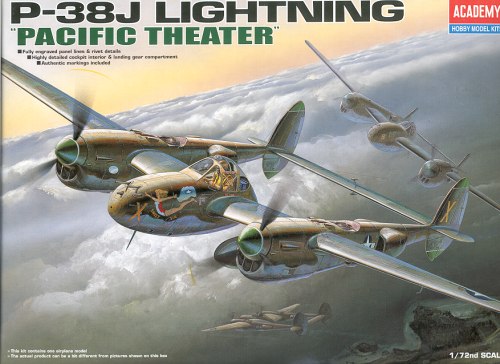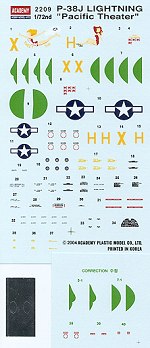
|
KIT: |
Academy 1/72 P-38J Lightning |
|
KIT # |
2209 |
|
PRICE: |
¥1600 (about $15) at Hobby Link Japan |
|
DECALS: |
Two options |
|
REVIEWER: |
Scott Van Aken |
|
NOTES: |
'Pacific Theater' boxing |

|
HISTORY |
This was really because the plane was not designed as a bomber escort and operating for long periods of time at high altitude brought on these disastrous problems that were really never cured. Going to a larger turbo intercooler helped a lot, but the plane was still experiencing problems with engines and turbochargers when it was eventually replaced by the P-51 in early 1944...but that is another story.
In the Pacific, the aircraft was just what the USAAF needed. It didn't have to fly at high altitudes and its twin engines gave the additional safety of that second engine, something that pilots appreciated when one was damaged and there was a long over-water flight ahead of them. Though fuel consumption was initially a problem, advanced engine management techniques and controls improved this vastly. Though not all that capable against Luftwaffe fighters, it was more than a match for much of what the Japanese could throw at it. Little surprise that it was the primary mount of the top scoring US aces of WWII.
|
THE KIT |

Academy models is becoming well known for producing updated kits of old favorites. While the older kits may well be perfectly good, these new ones are even better. This time, they've focused their attention on the P-38.
It may well be that this is a pantographed down version of their 1/48 P-38 kit. I can't tell as I've not built or even opened the box on those bigger versions, but what I can tell you is that this one seems very much like the 1/48 Hasegawa kit that I built well over a decade ago (has it been that long?). I say that because of the way there is piping in the wheel wells and the general look of the kit.
This is all good as the Hasegawa kit was the best around when it came out. A fussy build, but one that produced a fine looking model. This one has all those traits. The upper and lower wings are a single piece with the fuselage. This makes for a more positive construct. The tail booms are handed so one needs to take care when assembling these. This is an early J (up to P-38J-20) and not a later -25 or L as there are no anti-compressibility flaps under the wings and the ailerons do have trim tabs. To narrow it down even more, it is at least a J-10 as it has the flat panel windscreen introduced in this subtype and it does not have the wing leading edge landing light that was last used in the J-5.
Ok, so what about some options. Well, you have the
option to add or leave off the inside drop tanks and use either bombs or
bazookas. Or you can put nothing there, but I should tell you that
Lightnings were a bit thirsty and so needed at least the drop tanks. The
other option is to have the canopy open or closed and there are two
separate assemblies for you to make that choice. No cutting required. You
can also probably have the boarding ladder retracted. Though it isn't
shown in that way on the instructions, it should be easy enough to do.
I'd also be careful doing the prop blades as they are handed and will
look a bit odd if done wrong. Should also toss in here that this kit
will need nose weight and 10 grams is specified, I'd pack that nose.
is specified, I'd pack that nose.
The instructions are really very good. In the case of the main gear assembly, there are small photographs of how the completed assembly should look. Color information is supplied in generic terms in several languages, not a problem with this particular boxing. Color and decal instructions are on a separate sheet and provide for two OD over Neutral Grey aircraft from the 80 FS/8 FG. Both have green spinner fronts and green upper and lower fin tips. One aircraft is 'Sweet Sue' and the other 'Hill's Honey' with nose art. The decals are well printed though the nose art isn't that well detailed. They messed up and didn't initially provide handed decals for the fin tips but an addendum sheet takes care of that. I've had OK results with Academy decals, but many will undoubtedly go for aftermarket ones. A small sheet with chrome ovals for the side of the inner nacelles is also included.
Since this is a new mold kit, I'm sure we'll be seeing suitable sheets from Superscale and others very soon. Neither aircraft has a tail serial number so I cannot tell you if the markings are proper for the subtype that is kitted. Of course, many modelers are not that fussy about such minutia, but some are. Going through the reference, it seems as if the J-10s were camouflaged and the J-15s were bare metal. Naturally, that is only to be used as a guide, your mileage may vary! :O)
|
CONCLUSIONS |
Academy has, once again, provided an updated version of a kit that most 1/72 modelers have been awaiting. I'd be most surprised if we don't see a number of different variants. If you can't wait until this kit hits the shores of the US, you can get it now at www.hlj.com
|
REFERENCES |
Lockheed P-38J-L Lightning, Robert Peczkowski, Mushroom Model Magazine Special # 6109, 2003
If you would like your product reviewed fairly and quickly by a site that has nearly 250,000 visitors a month, please contact me or see other details in the Note to Contributors.